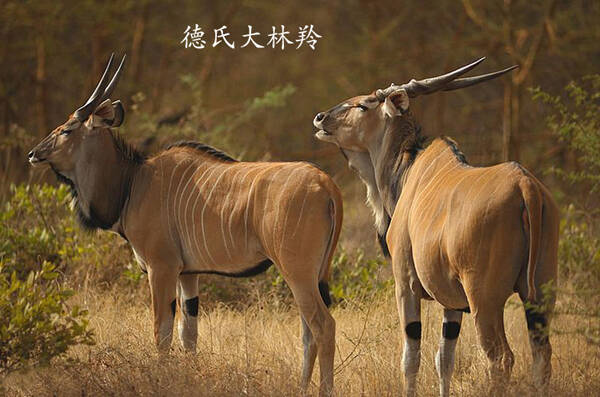Tragelaphus derbianus
IUCN
LCBasic Information
Scientific classification
- name:Tragelaphus derbianus
- Scientific Name:Tragelaphus derbianus
- Outline:Ungulata
- Family:Artiodactyla Bovidae Sapir
Vital signs
- length:210-345cm
- Weight:300-1000kg
- lifetime:About 25 years
Feature
Black marks on the ears and nose
Distribution and Habitat
Origin: Cameroon, Central African Republic, Chad, Guinea, Mali, Senegal, South Sudan.
Possibly extinct: Uganda.
Regionally extinct: Côte d'Ivoire, Gambia, Ghana, Togo.
The Desmosus sylvatica appears in sparse forests during the day to avoid the hot sun. It is active in the early morning and evening when the weather is cooler, searching for food in and around grasslands. It lives in mountainous areas up to 4,500 meters above sea level.
Appearance
The Desmos is huge, with males larger than females, weighing between 400-1000 kg; females weigh between 300-600 kg. The shoulder height is 130-180 cm and the body length is 210-345 cm. They all have huge spiral horns, 123 cm long for males and 66 cm long for females. The Desmos has sandy gray fur with 8-12 white vertical stripes on the sides. There are black marks on the ears and nose, and mature males have a large piece of fat on their black necks that extends from the chin to the chest.
Strong physique; with legs suitable for long-distance running; there are 4 toes on the feet, but the lateral toes are more degenerate than those of deer, which are suitable for running; the incisors and canines are degenerate, but the lower incisors are retained, and the lower canines are incisorized, with three pairs of incisors tilted forward and shovel-shaped. Because they feed on relatively hard plants, the premolars and molars have high crowns, the enamel is wrinkled, and the surface forms com
Details
Giant Eland (scientific name: Tragelaphus derbianus) has two subspecies.

Giant Eland usually gathers in small groups of about 25, but large groups are not uncommon. The migration of the herd depends on the changing patterns of the seasons. Mature males are usually solitary, and male-female contact can last from a few hours to a few weeks. Dominance is determined by the males in the group and affects the chances of mating with females. Males use their horns in active interactions to determine priority during the mating season. Females tend to live with their young in their own herds. Once the young are weaned, they will join mixed-sex juvenile groups for about 2 years. They then join sexually mature neutral herds.
Desmos are herbivorous animals. Food includes leaves, grass stems, grass blades and fruits. Their long horns are sometimes used to pick up leaves from high branches.
Desmos mating is usually during the rainy season. The dominant male will mate with several females. The estrus period lasts about 3 days. The gestation period lasts 8-9 months, and each litter produces one baby. The young live loosely around their mothers. Weaning takes 4-6 months, after which the young will permanently leave their mother group and join other groups of adolescents. Sexual maturity is reached around 2 years old. Life expectancy is up to 25 years.

The number of De's antelope has been declining due to overhunting by humans, habitat destruction caused by agricultural expansion, and the spread of plague. The majority of these live in protected park areas in southeastern Senegal.
The main surviving species of the eastern subspecies of Desmarai live in northern Cameroon and most of the 27 surrounding hunting concessions in most of the CAR hunting areas, including Chinko. However, many of the CAR hunting concessions are inactive due to political unrest and insecurity, which also affect management by the relevant authorities. Niokolo-Koba N.P. in Senegal is the only known area where the nominate subspecies lives, but this is likely to be no more than 150-200 individuals. Effective long-term management of national parks and hunting concessions in Cameroon and eastern CAR will contribute to the survival of the eastern subspecies. The survival of the western nominate subspecies depends on the continued protection of the species in Niokolo-Koba, Senegal.
Individuals of both subspecies of Desmarai are kept in captivity. A semi-captive breeding group of Western Giant Eland using Niokolo-Koba founders was established in Bandia Reserve, Senegal in 2000. Bandia had 30 births between 2000 and 2006, and a second enclosure has been established in Fathala Reserve, with a male-only group and a breeding nucleus, which was transferred in mid-2006. The semi-captive populations in Bandia and Fathala Reserves totaled 92 animals in 2013.
Listed in the 2017 IUCN Red List of Threatened Species ver 3.1 - Vulnerable (VU).
Protect wildlife and eliminate bushmeat.
Maintaining ecological balance is everyone's responsibility!








